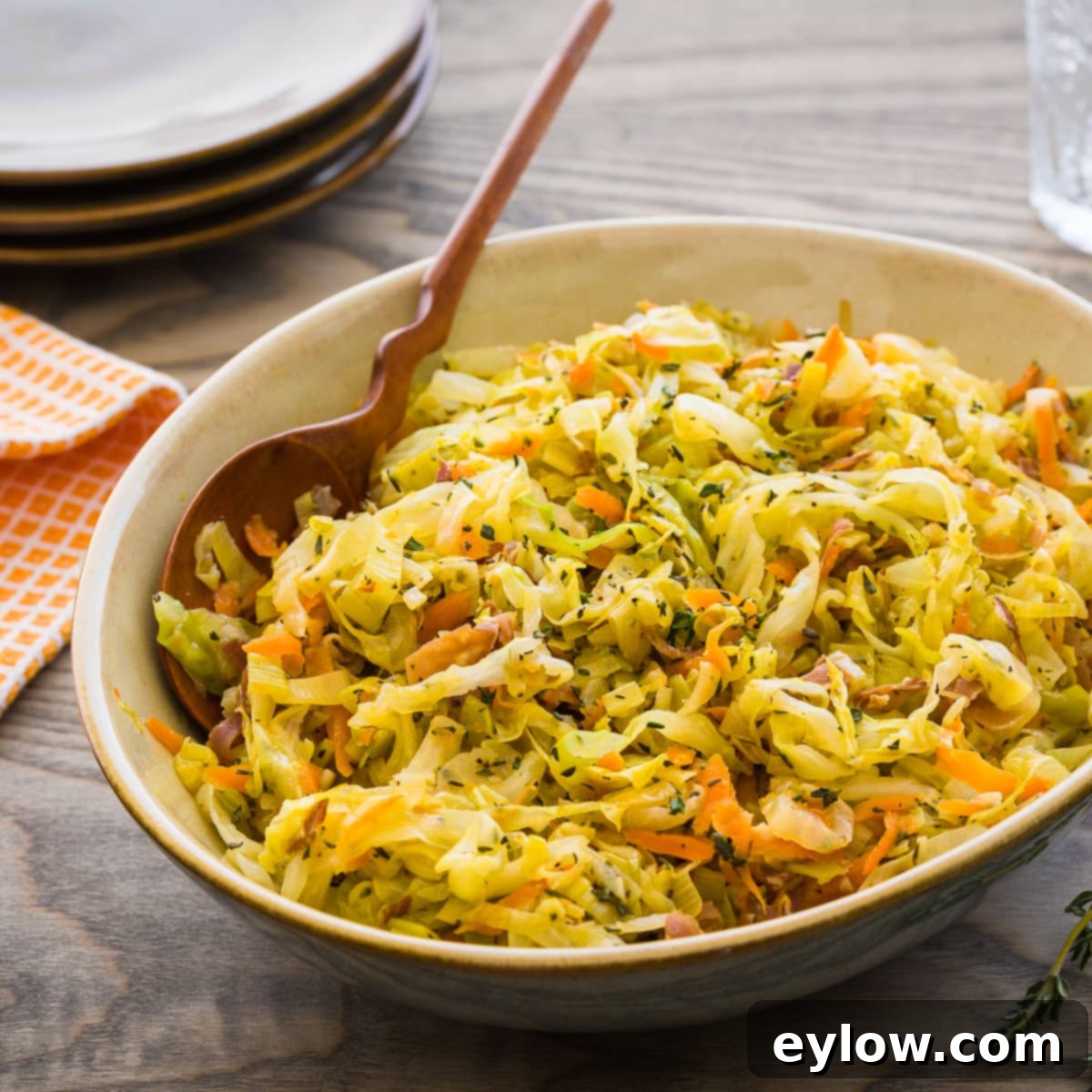Flavorful Braised Cabbage with Crispy Bacon: Your Go-To Irish-Inspired Side Dish
Transform humble cabbage into an extraordinarily rich, savory, and incredibly satisfying side dish in mere minutes with this delightful braised cabbage recipe. Forget bland, watery boiled cabbage; this version elevates the vegetable with the irresistible smoky notes of bacon, tender leeks, sweet carrots, and aromatic herbs. It’s a perfect accompaniment for holiday feasts like St. Patrick’s Day, beautifully complementing roast chicken or succulent salmon. Beyond special occasions, its quick preparation – just a few minutes of active cooking and under 20 minutes total – makes it an ideal weeknight side. For a truly memorable weekend breakfast or brunch, simply top a generous serving with a perfectly poached egg. Cabbage, it turns out, is capable of so much more than just coleslaw!

While corned beef and cabbage has become an iconic American St. Patrick’s Day tradition, the true classic family meal in Ireland has historically centered around cabbage and bacon. This easy, authentic Irish-style braised cabbage recipe honors that tradition, intelligently skipping the boiling method in favor of a flavorful braise. By gently cooking the cabbage in savory chicken or vegetable broth, alongside sweet carrots, aromatic leeks, and fragrant thyme, we unlock deeper, more nuanced flavors and a superior texture that boiled cabbage simply can’t achieve. This gentle braising process ensures the cabbage remains tender yet retains a slight bite, absorbing all the delicious seasonings, rather than leaching its nutrients and flavor into water. It’s a comforting, hearty dish that tastes like home, no matter where you celebrate.
[feast_advanced_jump_to]
Why You’ll Fall in Love with This Braised Cabbage Recipe
This Braised Cabbage with Bacon isn’t just another side dish; it’s a culinary revelation that will quickly become a staple in your kitchen. Here’s why you’ll absolutely adore this recipe:
- Effortlessly Fast and Easy: Forget long cooking times or complicated steps. This recipe comes together with minimal prep and cooks in under 20 minutes, making it the perfect choice for busy weeknights when you crave a homemade, flavorful side without the fuss. The simple technique of braising ensures a quick and delicious outcome every time.
- Budget-Friendly and Always Accessible: Green cabbage, the star of this dish, is one of the most economical and readily available vegetables year-round. You don’t need exotic ingredients to create something truly special. This recipe proves that humble ingredients can yield gourmet results without breaking the bank.
- A Symphony of Hearty Irish Flavors: Rooted in traditional Irish cuisine, this dish combines simple, wholesome ingredients like cabbage, bacon, leeks, and carrots to create a profoundly comforting and richly flavored experience. It brings the authentic taste of an Irish family meal right to your table, satisfying your cravings for hearty, rustic food.
- Incredibly Versatile: While it shines on St. Patrick’s Day, this braised cabbage is much more than a holiday special. It pairs beautifully with a wide array of main courses, from roasted meats to pan-seared fish. You can even enjoy it as a light meal on its own, especially when topped with a protein-packed poached egg.
- Nutrient-Packed Goodness: Cabbage is a powerhouse of vitamins, minerals, and fiber. Braising preserves more of its nutritional value compared to boiling, allowing you to enjoy a delicious dish that also contributes significantly to your healthy eating goals. It’s a fantastic way to increase your vegetable intake.
For another fantastic recipe to serve on St. Patrick’s Day or any day you’re craving comforting flavors, try this Cauliflower Colcannon.
Essential Ingredients for Braised Cabbage with Bacon
Crafting this incredibly flavorful braised cabbage dish requires just a handful of fresh, simple ingredients, each playing a crucial role in building its rich taste and texture. Here’s a closer look at what you’ll need:

- Green Cabbage: The undisputed star of the dish. Choose a firm, dense head of green cabbage. Its mild, slightly peppery flavor and hearty texture hold up beautifully to braising, transforming into a tender, succulent vegetable that soaks up all the other flavors.
- Bacon: The secret weapon for adding incredible depth, savory richness, and a delightful smoky crunch. We recommend uncured pork bacon for the best flavor, but feel free to experiment with turkey bacon for a leaner option, or omit it entirely for a vegetarian dish (though you’ll want to add a smoky element like smoked paprika in that case).
- Leek: Provides a subtle, sweet oniony flavor that’s milder and more refined than a standard onion. Use only the pale green and white parts, as the dark green tops can be tough and bitter. Proper cleaning of leeks is essential to remove any hidden dirt.
- Garlic: Fresh whole cloves of garlic, finely chopped or minced, are highly recommended for the most potent and aromatic flavor. It adds a pungent warmth that complements the other ingredients beautifully.
- Carrots: Not just for color, grated carrots lend a natural sweetness that balances the savory bacon and earthy cabbage. They also add a lovely textural contrast to the dish.
- Oil: Extra virgin olive oil or avocado oil are excellent choices for sautéing the vegetables. Alternatively, you can embrace the full flavor profile by using only the rendered bacon fat. This adds another layer of smoky richness to the dish.
- Broth: Low-sodium chicken broth is preferred for its savory base, allowing you to control the overall saltiness. For a vegetarian or vegan version, a good quality vegetable broth works perfectly. The broth is essential for braising, helping the cabbage soften and infusing it with flavor.
- Herbs: Fresh thyme brings an earthy, aromatic note that is classic in Irish cooking. Fresh parsley, added at the end, brightens the dish with a vibrant, fresh finish. A bay leaf adds a subtle, deep herbal background flavor that permeates the broth during cooking.
For precise measurements of these ingredients, along with salt and black pepper recommendations, please refer to the comprehensive recipe card below. Adjust seasoning to your personal taste!
Salmon is another terrific dish to serve on St. Patrick’s day (and any day). Try my simple steamed salmon recipe. It’s foolproof and pairs wonderfully.
Exciting Substitutions and Flavorful Variations for Your Braised Cabbage
One of the joys of cooking is adapting recipes to your taste or what you have on hand. This braised cabbage is incredibly versatile, offering numerous possibilities for delicious twists:
- Cabbage Choices: While green cabbage is traditional, don’t hesitate to experiment!
- Try Savoy cabbage in place of green cabbage. It’s known for its crinkled, tender leaves and slightly milder, sweeter flavor, which makes for a particularly delicate braised dish.
- Napa cabbage is another excellent variation. It has an even softer, more delicate texture and a distinct sweetness, cooking down very quickly and offering a different mouthfeel.
- For a pop of color and a slightly more pungent flavor, red cabbage can be used. Be aware that its color may bleed into the other ingredients, giving the dish a beautiful purple hue.
- Bacon Alternatives: If bacon isn’t your preference or you’re looking for something different:
- Swap pancetta for the bacon. This Italian cured pork belly is still rich and savory but often a bit saltier and less smoky than American bacon, providing a sophisticated twist.
- Substitute bits of finely chopped ham or leftover corned beef instead of bacon. These options will infuse the dish with a delicious, cured meat flavor.
- For a vegetarian option, simply omit the bacon. To add a smoky depth, consider incorporating a teaspoon of smoked paprika or a dash of liquid smoke.
- For a vegan version, omit all meat products and use vegetable broth. Enhance the umami with a splash of soy sauce or tamari.
- Aromatic Additions:
- Add chopped scallions (green onions) at the end for an extra layer of fresh onion flavor and a vibrant green color.
- Incorporate caraway seeds. This traditional addition is often found in German and Eastern European cabbage dishes, lending a warm, slightly licorice-like flavor that pairs wonderfully with cabbage. Add them with the thyme.
- If leeks are unavailable, slivers of red onion or yellow onion can be used as a substitute, though their flavor will be slightly sharper.
- Tangy Twists:
- For a German-style or slightly tangy twist, add 1-2 teaspoons of apple cider vinegar, white vinegar, or white wine vinegar near the very end of cooking. This brightens the flavors and adds a subtle, refreshing tang that cuts through the richness.
- A squeeze of fresh lemon juice can also achieve a similar brightening effect.
- Spice It Up: A pinch of red pepper flakes can add a welcome subtle heat if you enjoy a little kick.
If you cringe at mayonnaise-heavy coleslaw, try my easy coleslaw recipe with a light and creamy dressing – it’s a refreshing alternative!
Step-by-Step Guide: Crafting Your Perfect Braised Cabbage
Preparing this braised cabbage is a straightforward process, designed for maximum flavor with minimal effort. Instead of cooking large cabbage wedges, which can take longer and result in uneven texture, we’ll thinly slice the head of cabbage. This method ensures quick, even cooking and allows the cabbage to absorb the rich braising liquid more effectively. You’ll need a large pan to comfortably hold all the vegetables, such as a 12-inch fry pan or a spacious sauté pan, to avoid overcrowding and ensure proper browning and tenderization.
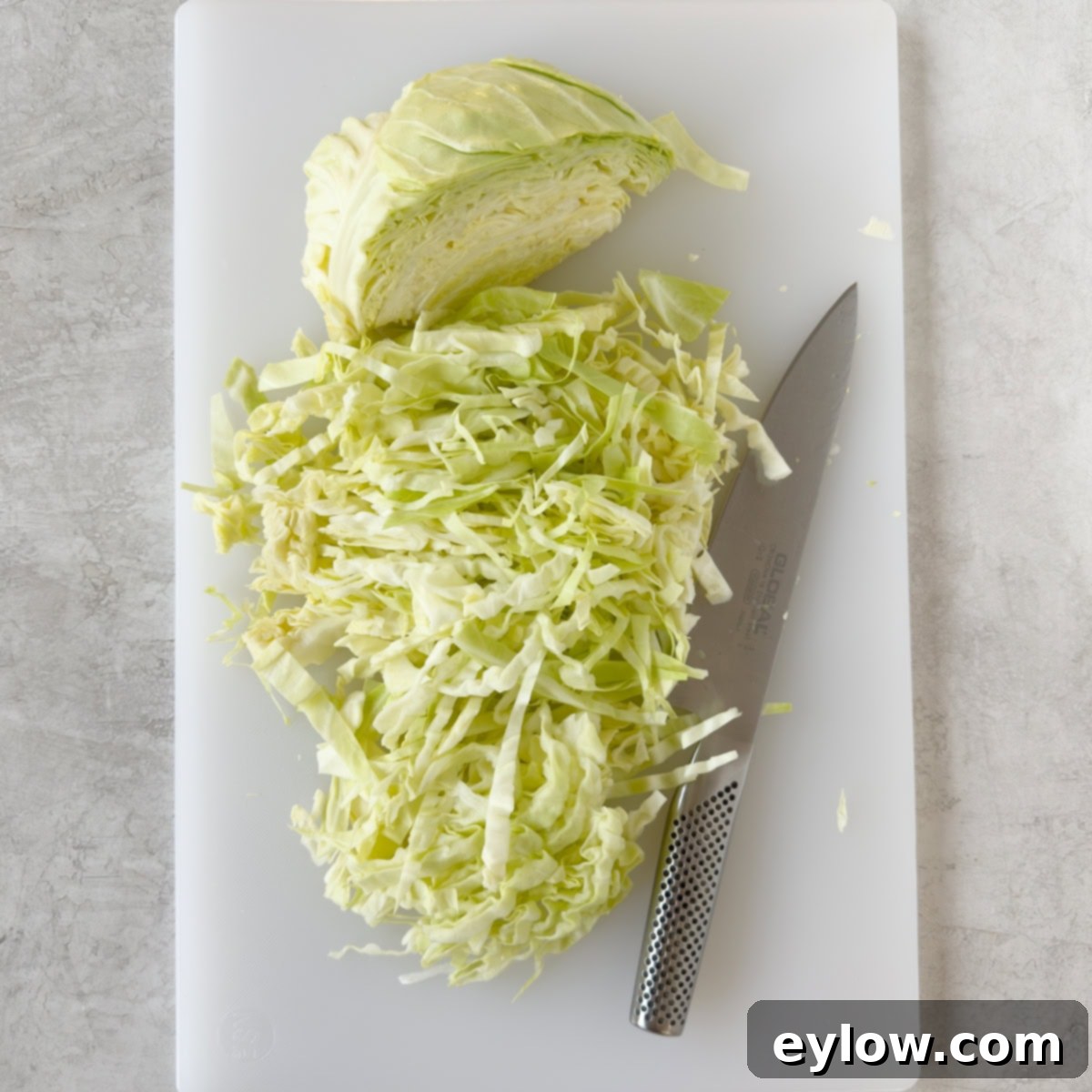
- Prepare Your Vegetables: Begin by thoroughly cleaning the leek. Cut off the root end and the tough, dark green top, reserving only the pale green and white parts. Slice the leek in half lengthwise, then fan out the layers and rinse thoroughly under cold running water to remove any hidden grit or sand. Once clean, pat dry and thinly slice crosswise. Next, grate your carrot (or julienne if preferred for a different texture). For the cabbage, cut the head in half through the root, then place each half flat on your cutting board and slice crosswise into thin ribbons, about ¼-inch thick. Chop your fresh herbs (thyme and parsley). This precise preparation ensures even cooking.
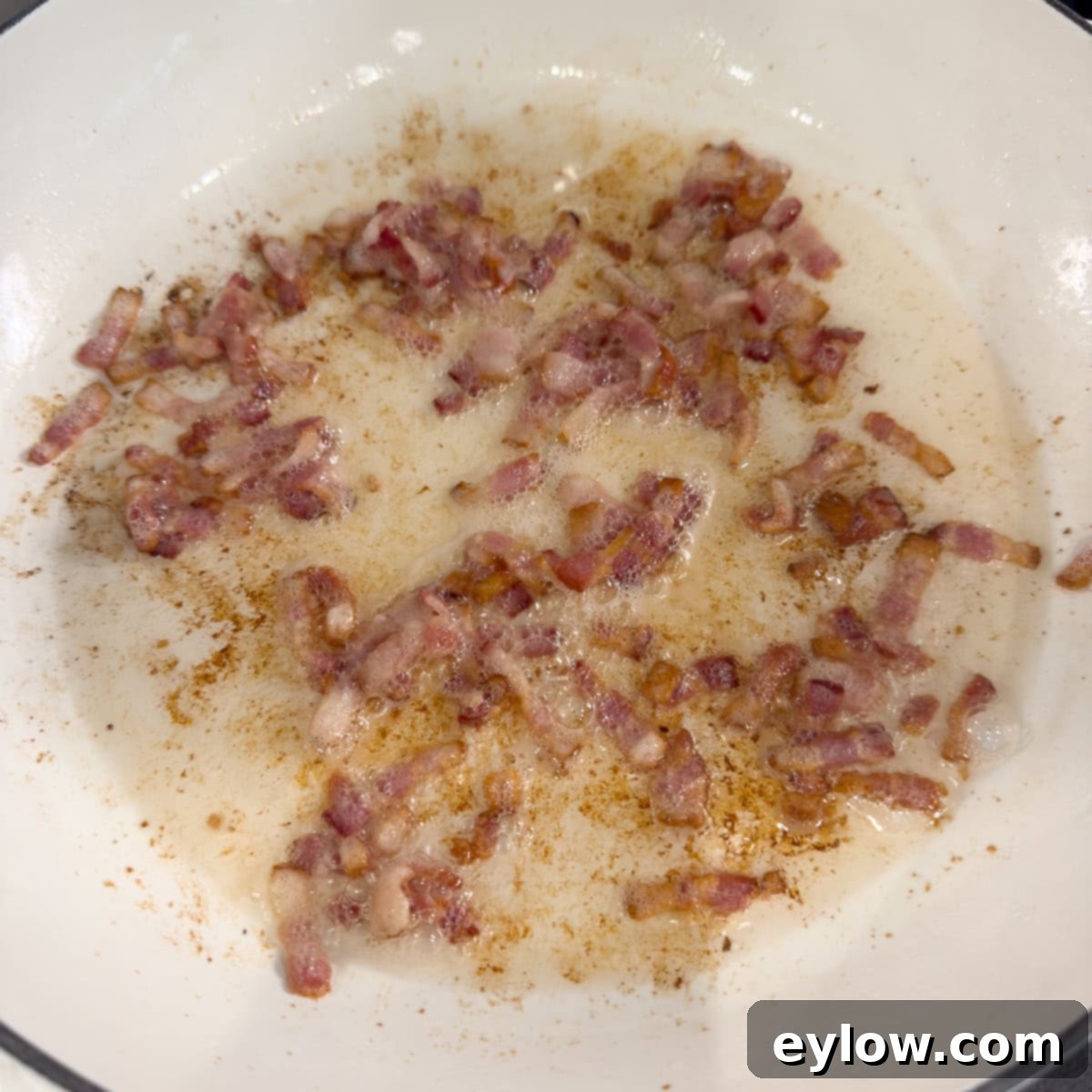
- Render the Bacon: Dice your bacon into small, even pieces. Place a large sauté or fry pan over medium heat and add the chopped bacon. Cook, stirring occasionally, until the bacon is beautifully crisp and has rendered most of its fat. Once done, use a slotted spoon to remove the crispy bacon pieces and transfer them to a plate lined with paper towels to drain. Reserve about 1 tablespoon of the flavorful bacon drippings in the pan – this will be your base fat for sautéing the other vegetables. Carefully wipe out any excess drippings from the pan with a paper towel if there’s more than a tablespoon, as too much fat can make the dish greasy.

- Sauté Aromatics: If you’re not using all bacon fat, add 1 tablespoon of olive oil (or avocado oil) to the pan with the reserved bacon drippings. Increase the heat slightly to medium-high. Add the prepared leeks and carrots to the pan and cook for approximately 2-3 minutes, stirring frequently, until they begin to soften and become fragrant. Then, add the finely chopped garlic and cook for just 1 minute longer, stirring constantly, until aromatic. Be careful not to burn the garlic, as it can turn bitter.
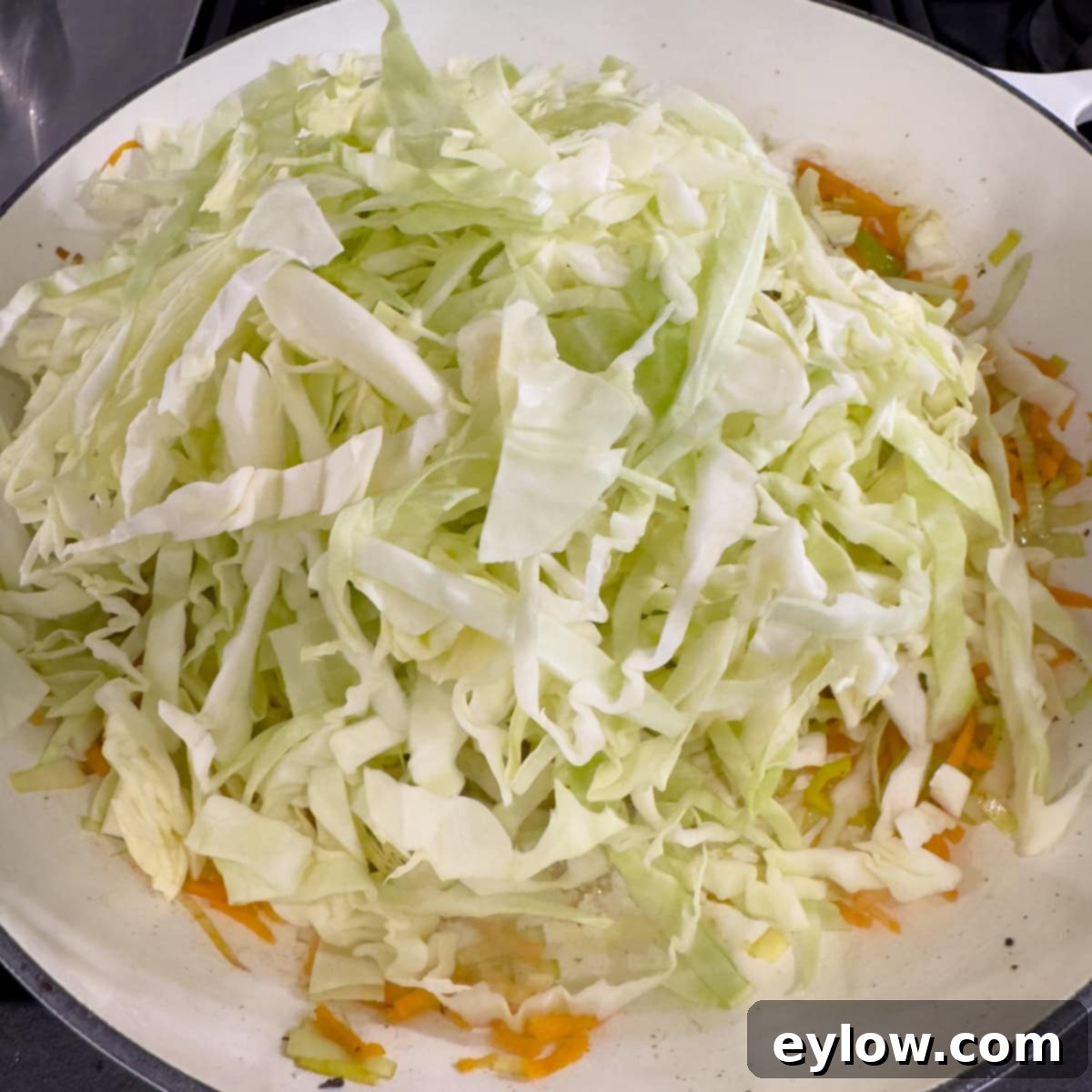
- Add Cabbage and Braising Liquid: Introduce the thinly sliced cabbage into the pan. It might seem like a lot, but it will quickly cook down. Pour in the chicken or vegetable broth, add the fresh thyme, and tuck in the bay leaf. Use tongs or a spoon to gently turn and mix all the ingredients together, ensuring the cabbage is well coated with the broth and pan juices. Season lightly with a pinch of salt and black pepper at this stage.
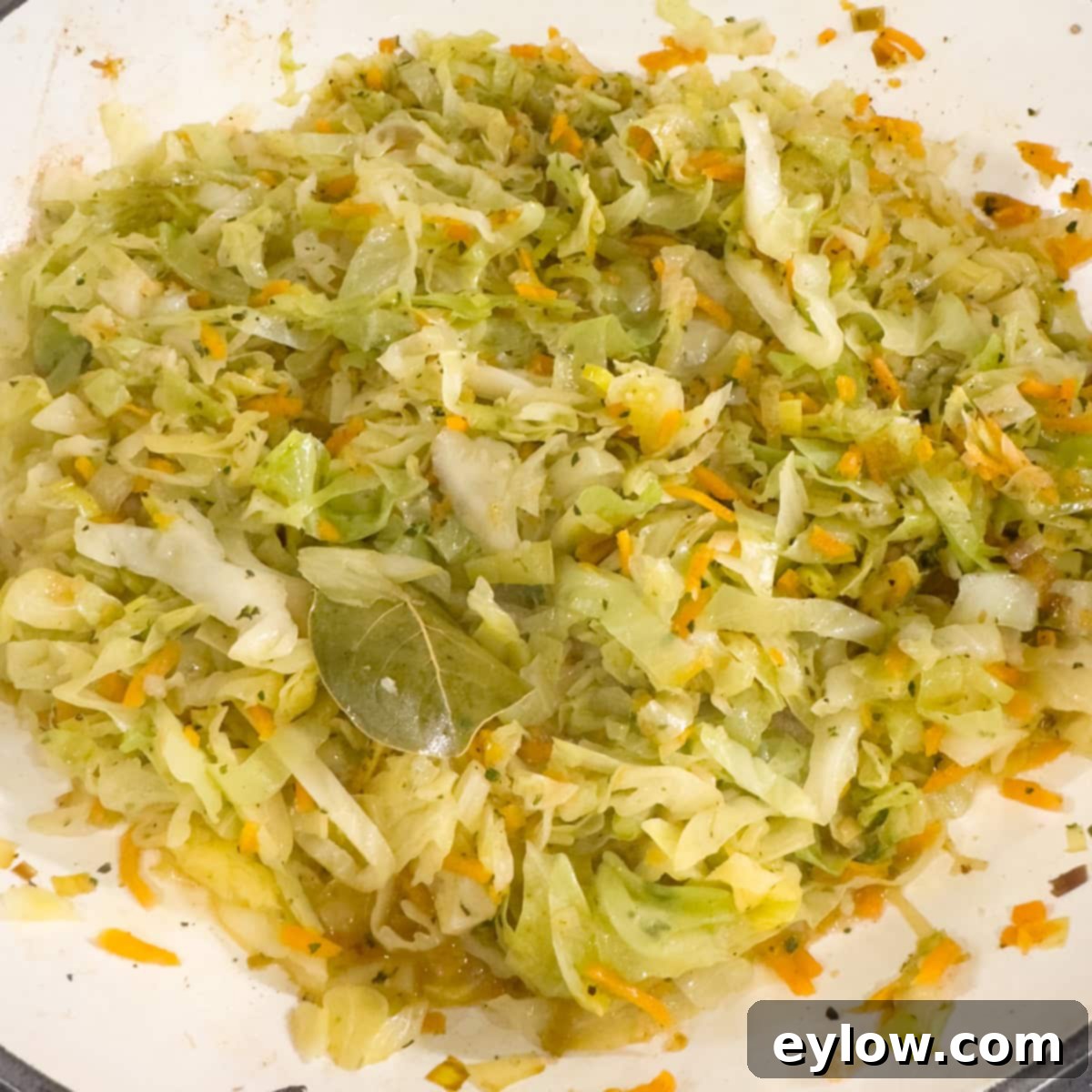
- Braise Until Tender: Cover the pan tightly with a lid to trap the steam and moisture. Reduce the heat to medium-low and allow the vegetables to braise until the cabbage is soft and wilted to your liking. This typically takes about 7-10 minutes. Stir occasionally to ensure even cooking. Taste a piece of cabbage to check for doneness; if you prefer it softer, continue cooking for another 1-2 minutes, keeping it covered. Once tender, remove the bay leaf and discard it.
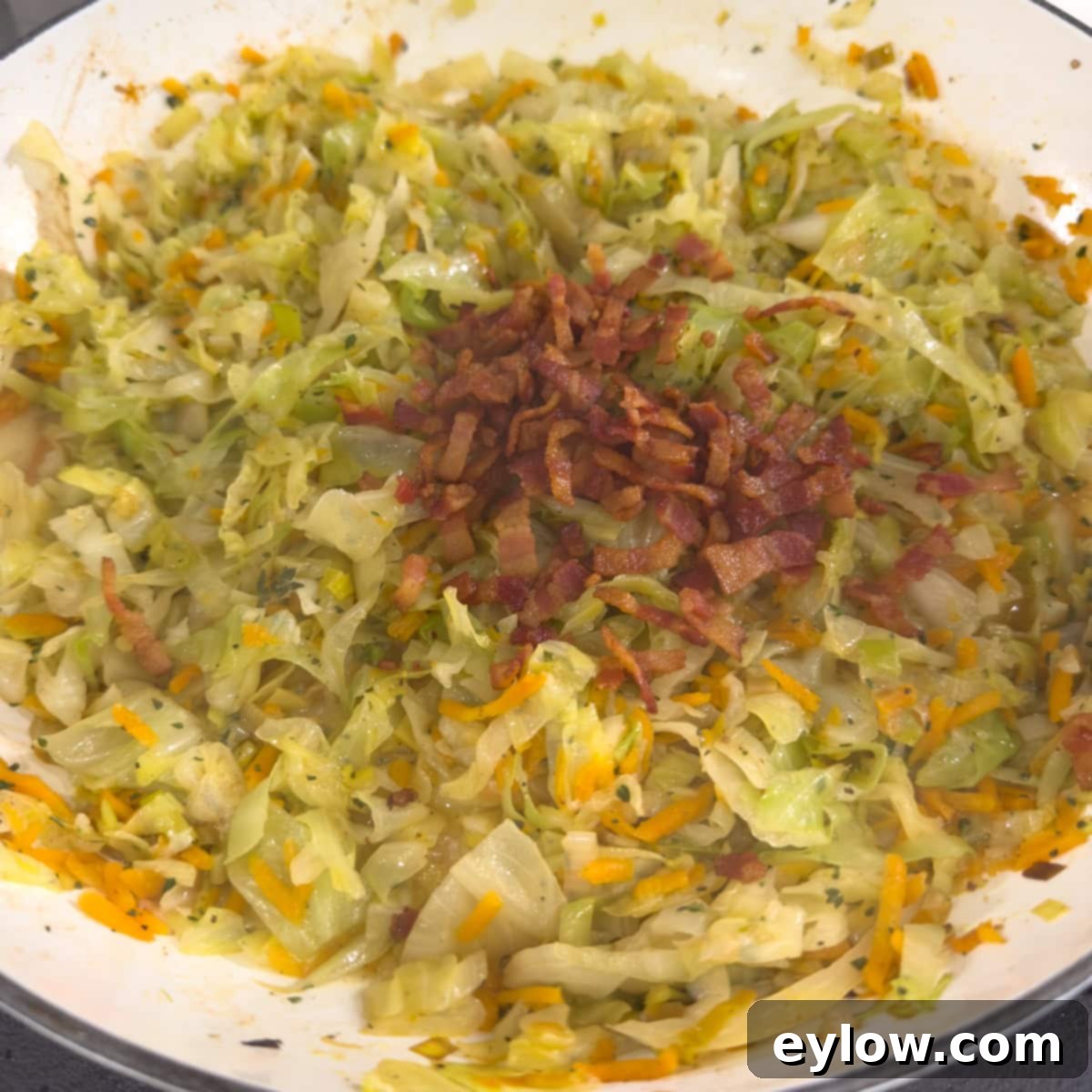
- Finish and Serve: Once the cabbage reaches your desired tenderness, stir in the reserved crispy bacon pieces. If you’re using fresh parsley, sprinkle it generously over the dish for a burst of fresh flavor and color. Taste the braised cabbage and adjust the seasoning with additional salt and black pepper as needed. Serve immediately as a warm and comforting side dish.
Chef’s tip: Embrace the Power of Cabbage! Don’t underestimate the humble cabbage. As an inexpensive and consistently available member of the cruciferous vegetable family, it’s an absolute nutritional powerhouse. Cabbage is remarkably rich in antioxidants, beneficial phytonutrients, essential vitamins (like C and K), vital minerals, and dietary fiber. Beyond this delectable braised cabbage recipe, it offers incredible versatility in the kitchen. Enjoy it raw in vibrant salads, finely shredded for flavorful tacos, added to hearty vegetable soups, or even juiced for a surprisingly sweet and refreshing green drink. Of course, it’s also the cornerstone of classic coleslaw. However you choose to incorporate it, make an effort to get more healthy cabbage into your diet. Plus, for those watching their carb intake, it’s an excellent low-carb vegetable option, making it a healthy and satisfying choice for almost any meal.
Delightful Serving Suggestions for Braised Cabbage
This flavorful braised cabbage with bacon is incredibly versatile and makes a perfect side dish for a wide array of main courses. Its rich, savory profile complements both light and hearty meals beautifully.
- Classic Pairings: It shines alongside succulent baked chicken breasts, perfectly pan-seared or stovetop seared salmon, and tender pork tenderloin or juicy pork chops. The flavors meld harmoniously, creating a balanced and satisfying meal.
- Traditional Irish Meal: Serve it as part of a complete Irish-inspired dinner. While corned beef is common, consider pairing it with a traditional Irish ham or a savory lamb stew for an authentic experience.
- Breakfast & Brunch Brilliance: For a hearty and unique breakfast or brunch, top a generous serving of braised cabbage with a perfectly poached egg. The runny yolk adds an extra layer of richness that’s simply irresistible.
- Alongside Potatoes: Potatoes are a must with almost any Irish-inspired dish!
- For ultimate comfort, serve it with fluffy riced mashed potatoes for the best, creamiest mashed potato experience.
- Alternatively, roasted red potatoes with rosemary offer a crispy, aromatic counterpoint that adds another textural dimension to your meal.
- With Sausages: Braised cabbage is also fantastic with grilled or pan-fried sausages, whether it’s traditional Irish sausages or another variety you enjoy.
- Vegetarian Options: If serving a vegetarian meal, this dish can be made vegetarian by omitting bacon (and replacing bacon fat with olive oil) and using vegetable broth. It pairs wonderfully with hearty vegetarian sausages, lentil loaf, or even a robust mushroom steak.
How to Store and Reheat Braised Cabbage Leftovers
One of the great advantages of this braised cabbage recipe is that it reheats beautifully, often tasting even better the next day as the flavors have more time to meld. This makes it an excellent candidate for meal prepping ahead of time.
- Storage: Allow the braised cabbage to cool completely to room temperature before storing. Transfer it to an airtight container and refrigerate for up to 3 days. For longer storage, you can freeze it in a freezer-safe container for up to 1-2 months. If freezing, be aware that the cabbage might become slightly softer upon thawing.
- Reheating on the Stovetop: For best results, reheat leftovers in a skillet over low to medium-low heat. Add a splash of broth or water if it seems dry. Cover the skillet and heat gently, stirring occasionally, until warmed through. This method helps maintain its texture and prevents it from drying out.
- Reheating in the Oven: Alternatively, you can reheat larger portions in a warm oven. Place the braised cabbage in an oven-safe dish, cover it tightly with aluminum foil to retain moisture, and bake at 300-325°F (150-160°C) for about 15-20 minutes, or until heated through.
- Microwave: For a quick individual serving, microwave on medium power, stirring halfway through, until hot. Be careful not to overheat, as this can make the cabbage mushy.

Frequently Asked Questions About Braised Cabbage with Bacon
While green cabbage is the most common and traditional choice for its balanced flavor and hearty texture, Savoy cabbage also works exceptionally well, offering a slightly milder taste and a more tender, delicate texture. For a sweeter and very soft result, Napa cabbage is a great option. Red cabbage can be used for a beautiful color, but be aware that its vibrant purple hue will likely bleed into the other ingredients during cooking, giving your dish a distinct purple tint.
Absolutely! If you’re looking for a meaty alternative to bacon, try using finely diced smoked sausage, pancetta, or chopped ham for a similar savory depth. For a delicious vegetarian version, simply omit the meat. To compensate for the lost smoky flavor, add a teaspoon of smoked paprika and ensure you use vegetable broth. For a completely vegan adaptation, omit all meat and use vegetable broth, perhaps adding a dash of soy sauce or nutritional yeast for an extra layer of umami.
Yes, you certainly can! While bacon fat imparts a unique, delicious flavor to the dish, other fats work very well. Butter adds a rich, creamy taste, while ghee offers a nutty, clarified butter flavor. Olive oil or avocado oil are excellent plant-based options that contribute a neutral flavor, allowing the other ingredients to shine. Feel free to use what you have on hand or what best suits your dietary preferences.
The key to perfectly tender (not soggy) braised cabbage is to avoid overcooking. Cabbage cooks down relatively quickly, so braise it just until it reaches your desired tenderness. It should be soft but still have a slight al dente bite. Another helpful tip is to cook the cabbage uncovered for the last few minutes if you notice too much liquid accumulating in the pan. This allows any excess moisture to evaporate, preventing a watery or soggy texture. Keep a close eye on it during the final stages of cooking.
A large, wide pan is ideal for this recipe. A 12-inch fry pan or a spacious sauté pan with a lid works perfectly. The wide surface area allows the cabbage to cook evenly and prevents overcrowding, which can steam the vegetables instead of braising them properly. A Dutch oven or a large, shallow pot would also be suitable.
Yes, this braised cabbage is an excellent make-ahead dish! Its flavors tend to meld and deepen upon resting, often tasting even better the next day. Follow the storage and reheating instructions above for best results. It’s perfect for meal prepping or preparing for a holiday meal, reducing stress on the day of serving.
More Delicious Recipes Featuring Cabbage
Cabbage is an incredibly versatile and healthy vegetable that deserves a regular spot in your diet. If you loved this braised cabbage, explore other exciting ways to enjoy it!
- Refreshing Green Juice with Cabbage and Celery
- Simple & Easy Homemade Coleslaw Recipe
⭐️Did You Make This Braised Cabbage?
If you prepare this delicious braised cabbage with bacon recipe, we’d absolutely love to hear from you! Your feedback is invaluable and helps other readers discover wonderful new dishes. Please take a moment to comment below and let us know how it turned out. Don’t forget to leave a star rating!
📖 Recipe

Braised Cabbage with Bacon
Sally Cameron
Pin Recipe
Ingredients
- 1 large leek pale green and white part only, thoroughly cleaned
- 1 small head green cabbage (about 4 cups thinly sliced)
- 4 strips bacon (uncured, diced)
- 1 tablespoon olive oil (or use only reserved bacon fat for richer flavor)
- 3 garlic cloves (finely chopped or minced)
- ¾ cup grated carrot
- ⅔ cup chicken broth (low sodium, or use vegetable broth for a vegetarian option)
- 2 teaspoons fresh chopped thyme
- 1 bay leaf
- 2 teaspoons fresh chopped parsley (optional, for garnish and freshness)
- Salt and freshly ground black pepper to taste
Instructions
Prep work for efficiency
-
To prepare the leek, cut off the root end and the tough dark green top, discarding them. Slice the remaining pale green and white part of the leek in half lengthwise. Fan out the layers and rinse them thoroughly under cold running water to remove any hidden sand or dirt. Pat dry, then lay them flat on a cutting board and chop thinly crosswise into half-moons.
For the cabbage, cut the head in half through its root. Place each half flat on your cutting board and slice crosswise into thin ribbons, approximately ¼-inch thick. You will need roughly 4 cups of packed, thinly sliced cabbage. Finely chop the fresh thyme and parsley (if using).
Slice the bacon crosswise into thin strips or small dice.
Cook bacon to crispy perfection
-
In a large sauté or fry pan (at least 12 inches in diameter) over medium heat, add the chopped bacon. Cook, stirring occasionally, until the bacon pieces are beautifully crisp and golden brown. This usually takes about 5-7 minutes. Using a slotted spoon, remove the cooked bacon pieces and transfer them to a plate lined with paper towels to drain excess fat. Leave approximately 1 tablespoon of the flavorful bacon drippings in the pan. If there’s more, carefully pour off the excess or wipe it out with a paper towel.
Braise the cabbage to tender, savory perfection
-
If desired, add 1 tablespoon of olive oil to the pan with the reserved bacon fat. Heat the oil over medium heat. Add the prepared leek and grated carrot to the pan and cook for about 2-3 minutes, stirring frequently, until they have softened slightly and become fragrant. Next, add the finely chopped garlic and cook for just 1 minute longer, stirring constantly, until it becomes aromatic. Be careful not to burn the garlic.
Add all of the thinly sliced cabbage to the pan. It may look like a lot, but it will quickly reduce in volume. Pour in the chicken broth, sprinkle in the fresh chopped thyme, and add the bay leaf. Use tongs or a spoon to stir and turn the vegetables, ensuring they are well coated with the broth and pan juices. Season lightly with a pinch of salt and a grind of fresh black pepper at this stage.
Cover the pan tightly with a lid. Reduce the heat to medium-low and allow the vegetables to braise until the cabbage is soft and wilted to your preference. This typically takes about 7 minutes. Taste a piece of cabbage to determine if it’s done enough for you; if you prefer it even softer, cover and cook for another 1-2 minutes.
Once the cabbage is tender, remove the bay leaf and discard it. Stir in the reserved crispy bacon pieces. If you’re using fresh chopped parsley, sprinkle it over the dish for a burst of freshness and color. Taste the braised cabbage and adjust the seasoning with any additional salt and pepper as needed before serving warm.
Notes
- For a more delicate texture and slightly milder flavor, try using Savoy cabbage in place of the green cabbage. It braises beautifully and is often preferred for its tender leaves.
- Napa cabbage is another excellent choice, offering a softer texture and a slightly sweeter profile. It cooks down even more quickly due to its delicate structure.
- To vary the savory base, swap pancetta for the bacon. Pancetta is Italian cured pork belly, similar to bacon but often less smoky and sometimes a bit saltier, providing a refined richness.
- Alternatively, substitute bits of finely chopped ham or leftover corned beef instead of bacon for a different cured meat flavor. These additions are perfect for utilizing leftovers and adding a hearty dimension.
- For an aromatic addition and a traditional twist, stir in 1 teaspoon of caraway seeds along with the thyme. Caraway adds a warm, distinctive flavor that pairs exceptionally well with cabbage.
- If fresh leeks are unavailable, you can substitute with thinly sliced red onion or yellow onion. Start with about half a small onion for a milder flavor.
- For a subtle tang that brightens the dish, add 1-2 teaspoons of apple cider vinegar, white vinegar, or white wine vinegar during the last minute of cooking. This is a common practice in German-style cabbage preparations.
Remember to adjust seasoning to taste throughout the cooking process.
